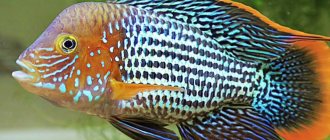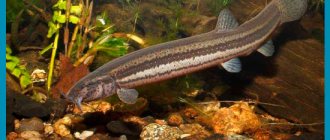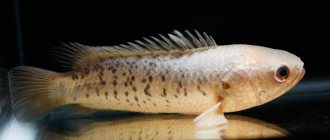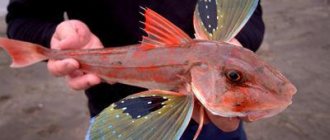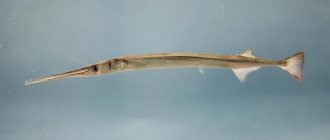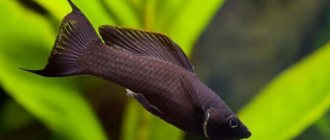There are a large number of different fish. They differ in size, shape, color, and habitat. Many of them are commercial. Pearl fish can be found in warm tropical waters. They have a beautiful pearlescent color.
Pearl fish gets its name from its silvery scales.
These aquatic inhabitants belong to the carpus family, which has several species.
What kind of fish
Pangasius belongs to the catfish family. The back is dark gray, the belly is light. The dorsal fin is small and shark-like, and a long solid fin extends from the tail to the middle of the belly. The head is oblong, the eyes are located close to the mouth. It is found in Chile and Argentina, as well as in lakes and rivers in Thailand, Cambodia, Laos and Vietnam. The highest density of fish per square kilometer is in the largest rivers of Indochina - the Irrawaddy, Chao Phray and Mekong. These reservoirs are the most polluted on the peninsula; household and chemical waste is dumped into them. But this does not scare away the fish. A hungry pangasius is able to eat and digest anything, even car tires, but prefers shellfish, small fish and algae.
The largest supplies to Russia and neighboring countries are made by Vietnam. In the 40s, large-scale farming of pangasius began. Large areas are set aside in natural river basins for fish farming. Garbage and waste do not get there, the water is carefully filtered, but despite this, some harmful substances remain. Artificial pools with fresh water without toxic compounds have also been created. Fish grown under such conditions is safe for the consumer. Rice, vegetables, soybeans and special high-calorie additives are used as feed.
Beneficial features
Pangasius, grown on farms in compliance with all standards, has beneficial properties due to its chemical composition.
Benefits of regular use:
- Prevents the occurrence of joint pathologies.
- Slows down external age-related changes.
- Strengthens memory.
- Prevents the initiation of degenerative processes in muscles and brain tissue.
- Increases the strength of tooth enamel and reduces bone fragility.
- Eliminates brittleness of nails and hair.
- Prevents the onset of early dementia.
- Nourishes the epidermis, making the skin elastic and smooth.
- Promotes mental stability in stressful situations.
- It has a beneficial effect on blood vessels, strengthening their walls.
Contraindications and possible harm
Recently, pangasius has become viewed with suspicion due to the spread of rumors about its toxicity. This information is only true for fish raised in their natural habitat. Meat does contain some harmful compounds. But in individuals caught in artificial reservoirs, they do not reach dangerous values. To intoxicate the body, an adult must eat at least 3.5 kg of fish daily for six months.
Rospotrebnadzor regularly checks the quality of products supplied to Russia. If violations are detected, a ban is imposed on the import of goods with indicators that do not meet the standards.
Pangasius should not be eaten:
- People with individual intolerance.
- If you are allergic to river and sea fish in any form.
- If the fish was stored incorrectly and has foreign odors.
- In large quantities, fillet is poorly digestible and slows down the gastrointestinal tract.
Description of carpus
The carp family includes 27 species. They mainly lead a benthic and benthic lifestyle. The body is long and laterally compressed, elongated towards the tail. These are marine pearl fish without scales that live in moderately warm waters. They can lead different lifestyles:
- independent;
- parasitic;
- commensal.
The average length of a carp fish is 7−8 cm
At the larval stage of development, the carp leads a planktonic lifestyle and soars peacefully in the water column. Some species lead a symbiotic lifestyle. They invade the body of the sea cucumber and feed on its gonads and aquatic lungs.
Thanks to the regeneration of lost parts, such a union is completely harmless to the wearer. Sometimes carp are found in the cavity of starfish and other sea creatures. The average length of an individual is 7−8 cm.
Pregnant and lactating
When breastfeeding, as well as for pregnant women, pangasius fish is not harmful to health; you can eat it if there are no contraindications. To prevent harmful effects on the child, it is recommended not to exceed the weekly norm. For expectant mothers it is 200 g. A nursing woman is allowed to eat the same amount.
Iron and phosphorus in fish have a positive effect on the development of organs of both the newborn and the baby in the womb. It is better to alternate the consumption of pangasius and other varieties of fish.
Summarize
- Pangasius fish has a mediocre nutritional profile and is best avoided.
- It is raised in overcrowded fish farms where chemicals and antibiotics are used in excess, causing water pollution and health problems.
- Sometimes it is mislabeled and sold as a more expensive fish. If you like to eat this fish, choose a brand with an eco-certification.
- Generally, it is best to eat a variety of fish. Healthy alternatives to pangasius include haddock, saltwater, salmon and many others.
- Related Posts
- Sea scallops: benefits and harm to the body
- Flounder: benefits and harm to the body
- Chicken feet: benefits and harm to the human body
Mercury testing
In 2017-2018, the Department of Toxicology of the University of La Laguna, together with the Canarian Health Service, conducted studies on the effect of pangasius on the human body. Scientists assessed the risks of mercury poisoning when consuming this type of fish.
More than 80 frozen pangasius samples from different manufacturers were taken for study. A wide range of mercury concentrations in the studied fillets was determined, with an average value of 0.22 mg/kg. Experts have set restrictions on the use of the product. The permissible weekly norm is 0.35 kg of finished fillet. This volume contains an acceptable amount of mercury that is not dangerous to human organs.
Composition and calorie content
Fish fillet is low in calories, but contains a wide range of minerals and vitamins.
Fatty acid:
- monounsaturated – 2.573 g;
- polyunsaturated – 1.119 g;
- saturated – 1.31 g;
- transpolyene – 0.024 g;
- trans-monoene – 0.028 g.
Per 100 g of product there are 55 g of cholesterol, vitamins A, B, D, E, C and K.
Fish meat saturates the body with aspartic acid, alanine, arginine, isoleucine, histidine, tyrosine and other important amino acids.
Mineral composition (per 100 g):
- zinc – 0.48 mg;
- selenium – 8.2 mcg;
- potassium – 302 mg;
- manganese – 0.015 mg;
- iron – 0.23 mg;
- sodium – 98 mg;
- copper – 0.032 mg;
- magnesium – 19 mg;
- calcium – 8 mg.
The ratio of BJU per 100 g is 15/30/0 (67%/30%/0%). This amount of fresh fish contains only 89 kcal. This is 7% of your daily calorie intake. If you want to lose excess weight, you must take into account that during cooking the energy value changes.
Calorie content table depending on cooking method, kcal (per 100 g)
| Fried | 187 |
| Fried in egg batter | 174,4 |
| Baked in the oven | 104,2 |
| Baked under a cheese cap | 203,4 |
| Boiled | 90,1 |
| For a couple | 90,7 |
| Stewed | 83,3 |
Study of chemical additives
In 2015, an article was published online based on the research work of Brazilian scientists. They conducted experiments on frozen pangasius samples taken from different Vietnamese suppliers to determine product quality, spoilage rates and the presence of toxic substances in accordance with safety standards.
Pangasius deteriorates very quickly. During storage, ammonia and biogenic amines are released; their level in fish fillets serves as an indicator of spoilage of the product.
The study showed that the values of these substances are acceptable, but in 80% of the tested samples they have already reached the normal limit.
Pangasius fillets have been tested for toxic compounds that enter the fish from the environment and during processing:
- Polyphosphates are an additive for binding water and fish carcass before freezing. If the permissible values are exceeded, the pulp becomes saturated with water, and protein levels are significantly reduced. This is how unscrupulous manufacturers increase the weight of their goods.
- Malondialdehyde is a product of lipid oxidation and is used to determine the level of rancidity in fish. Excess occurs due to improper or prolonged storage or poor processing. In high doses, it provokes mutations in cells and the formation of cancerous tumors in humans.
- Mercury is a heavy metal; it is found in high concentrations in polluted waters, which is where it enters the body of the pangasius.
Based on the analysis, facts of commercial fraud with polyphosphate were established in 30% of cases, unacceptable levels of toxic chemicals were found in 50% of samples.
Such results became the basis for tightening the approach to the selection of products during import.
Recommendations from nutritionists
Pangasius fillet is considered a dietary product. It can be used for diabetes, pancreatitis, and obesity.
However, the flesh of this fish is not quickly digested, so shark catfish fillets are used during a therapeutic diet in strictly limited quantities - no more than 100 g per day, twice a week.
Nutritionists recommend preparing soups based on fish broth, baking them in pieces on a bed of vegetables without oil and steaming them. By following the advice of experts, you can lose from 3 to 5 kg of excess weight per month and regain good health and energy.
Food for pearl
It's time to talk about diet. In principle, goldfish are omnivores; fresh, dry, and frozen food is suitable for them. It is important to note a number of features of her feeding. It is recommended to pre-moisten or rinse dry food in the form of granules or flakes, otherwise, once inside, the food will swell from absorbed moisture from the internal organs. Pressure on surrounding organs will increase, and the risk of damage to the swim bladder is especially high. Some authors recommend adding peas to the diet once a week to prevent constipation. There is often a tendency to overeating and obesity in pearls.
Sole tongue - how to distinguish
Pangasius is delivered to Russia gutted, unscrupulous entrepreneurs are trying to sell it under the guise of a more expensive fish - sole. Such a substitution promises good profit, since real sole is of great value to the body and costs much more. In order not to make a mistake and not pay a high price for a cheap product, it is worth knowing the distinctive features of pangasius:
- The fillet plates are thick.
- There is a noticeable layer of fat on the sides of the fillet.
- A bright brown-pink stripe is visible along the fillet from the ridge.
- The color is white-pink or gray.
- Pronounced river smell.
Bleak lifestyle
Another pearl fish is bleak. Its length does not exceed 20 cm, and its weight does not exceed 100 grams. Lives in water bodies of the temperate zone of Russia. The scales of the bleak are dark with a greenish tint, and the sides are steel-colored. Prefers to live in the upper layers of water.
Bleak prefers upper waters
Bleak feeds on plankton and dead insects. It is easy to spot on the surface of the lake, as it leads an active lifestyle. It is the constant movement that protects the fish from the danger of being eaten. At night, the bleak hides under thickets of surface plants or branches.
It reproduces actively from May to September, laying eggs every 15 days.
It has no commercial significance due to its small size. But some fishermen consider it suitable for fishing. Most often, bleak is dried.
How to choose and store correctly
Certified pangasius fish is not harmful to health. To ensure the quality of the purchased product, you need to ask the seller for sanitary documents for fish. Stores that value their reputation provide such information.
Fish is a perishable product, so you should make your choice responsibly. Otherwise, there is a high risk of poisoning.
Freshness is determined by 2 main criteria:
- By color. Fresh fillets are white, with a pleasant pink tint. Grayish pulp indicates improper storage and a long production period.
- By aroma. Pangasius meat smells like river silt. But if it is spoiled, a noticeable rotten smell appears.
Chilled fillets are not transported to Russia; due to the short shelf life, this is not advisable. The carcasses are cut up, blast-frozen and sent for sale.
You can store fish in the freezer for no longer than 30 days. After defrosting, it is prepared immediately, since without heat treatment the thawed fillet will spoil in 4 hours.
Is it possible to give pangasius to children?
Fish is an essential product in every person’s diet. Nutritionists suggest preparing fish dishes once or twice a week. For adults, the recommended amount of fish products is 140 g. For a growing child’s body, this is an indispensable nutritional element.
You can start eating fish food from 10 months, in portions of no more than 40 g. Children from the age of two can be given portions of 100 g. But with regard to shark catfish, many have doubts about its benefits and concerns about whether it is possible to give children dishes prepared from it.
All farms involved in breeding and selling pangausis are located in the Mekong River basin. This waterway has a bad reputation. The Mekong carries its waters through a densely populated area; waste from various industries and sewage flow into the river.
However, powerful fish production enterprises that have an international safety license do not catch fish in rivers, but grow them in special reservoirs. Of course, water is pumped into the ponds from the Mekong, and is purified by powerful filtering devices and aerated.
Farm enterprises have tightened requirements for sanitary indicators and quality at every stage of production. Carcass cutting is carried out in production facilities with the strictest sanitary standards. The fish are fed with nutritious granulated food made from fish waste, with added vitamins, observing all standards.
Pangasius is exported to the USA and European countries. The European Union closely monitors the quality of imported goods. In Russia, this function is the responsibility of Rosselkhoznadzor. In 2012 and 2014, these regulatory authorities banned several large producers from importing shark catfish into the country.
Small underground farms are not able to ensure compliance with all sanitary requirements for cleanliness and proper quality, but such goods will not end up on foreign shelves; they are sold in local markets.
Pangasius, contrary to all the rumors and myths, is an ordinary high-quality fish, unpretentious and omnivorous. On similar farms, under similar conditions in different countries, trout, sturgeon and other species are grown. Of course, it can be used in nutrition, and even necessary.
There is no more harm than chicken legs stuffed with hormonal drugs and antibiotics, but there are many benefits. However, it is advisable to purchase it in hypermarkets that are responsible for the quality of their goods and value their reputation. If there are no individual contraindications, then shark catfish meat can be safely used in the preparation of various delicious fish dishes.
What products does it combine with?
Pangasius pulp should be cooked only with products with which it is combined. Following this rule will ensure good digestibility and prevent heartburn and heaviness in the stomach.
Compatibility table with other products
| Fine | Ghee, whey, greens, cabbage, carrots, beets, pickles, green vegetables |
| Acceptable | Rice, buckwheat, lemon, quinoa, tomatoes, butter, vegetable oil, pumpkin, eggplant, zucchini |
| Badly | Meat, poultry, eggs, mushrooms, cream, sour cream, lard, nuts, seeds, potatoes, dairy products, cheeses, feta cheese, wheat, rye, oats, bread, peas, chickpeas, mung beans, beans, beans, lentils, |
Casserole
If you have some fillets in the refrigerator, then a recipe on how to make a fish casserole will come in handy. This dish can even be served to a child to feed him healthy food. This casserole is easy to prepare - you can use fresh or canned varieties. The appetizer is combined with potatoes, zucchini, carrots, and fried mushrooms. Seasonings include rosemary, nutmeg, and thyme. The casserole is best served with sour cream and grated cheese.
- butter – 30 g;
- flour – 40 g;
- milk - a glass;
- cheese – 40 g;
- salmon - half a kilo;
- green peas – 80 g;
- green onions, dill - a bunch;
- lemon juice – 20 ml;
- white rice – 400 g.
- Boil the rice until done. Finely chop the fish, mix with herbs, peas, marinate with a mixture of lemon juice, salt and pepper.
- Melt the butter over the fire, add the flour, cook for a minute over high heat, reduce the temperature, pour in the milk while stirring constantly. Cook for 4 minutes until thickened, mix with a third of the grated cheese.
- Pour the resulting bechamel sauce, half the rice, half the fish, again the sauce, half the cheese into the bottom of the baking dish. Repeat layers.
- Bake at 180 degrees for 27 minutes.
Cooking secrets
If you follow the universal cooking rules, the fish will turn out tender and aromatic:
- To maintain a dense structure and taste, defrost the carcasses at room temperature for 3-4 hours or on the bottom shelf of the refrigerator for 10-12 hours. It is not recommended to pour water over the fillets or use the microwave to speed up thawing.
- Remove excess moisture from the defrosted pulp using paper towels or napkins, then the fish will not disintegrate during cooking.
- Cooking time takes 8-10 minutes. Do not keep pangasius in water longer than expected, so that the meat does not boil and disintegrate into fibers.
- For optimal salting when baking or frying, 1 level teaspoon of salt per 1 kg of fillet is enough.
In cooking, fish is used in different ways - stuffed into pies, stewed with vegetables, baked with fruit, boiled and smoked. We offer you to prepare simple and tasty pangasius dishes according to our recipes.
Pangasius meatballs in tomato
Ingredients:
- fish fillet – 1 kg;
- tomato paste – 1 tbsp;
- onions – 4 pcs.;
- garlic – 2 cloves;
- city bun – 1 pc.;
- milk – 200 ml;
- tomatoes – 0.5 kg;
- carrots – 2 pcs.;
- flour – 3 tbsp;
- sugar – 2 4.l.;
- salt;
- black pepper;
- spices for fish;
- greenery.
Preparation:
- Cut the bun and soak it in milk. To make the meatballs more tender, you can use only the crumb.
- We pass two onions, along with fish and bread, through a meat grinder.
- Squeeze a clove of garlic into the resulting minced meat, add salt, sprinkle with black pepper and mix.
- Cover with cling film and put in the refrigerator for 20 minutes.
- Grate the carrots, cut the onion into half rings and fry them in a deep saucepan in vegetable oil for 10 minutes.
- Pour boiling water over the tomatoes, peel them, then cut them into large cubes and add them to the vegetables.
- Cover with a lid and simmer for 10 minutes.
- At this time, we form meatballs from minced meat, roll them in flour and fry on both sides until golden brown.
- In a separate frying pan, sauté the flour until slightly golden brown, stirring all the time. Do not overcook, otherwise the sauce will be bitter.
- Pour the flour into a saucepan, stir well, add tomato paste.
- Pour fish spices, sugar, salt into the sauce, mix and simmer for 3 minutes.
- Place the meatballs in a saucepan. Make sure the sauce covers them completely. If necessary, add water.
- Cover with a lid and simmer for 15 minutes. Before serving, sprinkle with herbs.
Pangasius in sauce with vegetables
Products:
- asparagus – 200 g;
- bell pepper – 4 pcs.;
- fresh green peas – 100 g;
- shark catfish pulp – 700 g;
- carrots – 2 pcs.;
- salt, pepper - to taste.
For the sauce:
- sour cream 20% – 150 g;
- hard cheese – 100 g;
- mustard – 50 g;
- lemon juice – 50 ml.
Preparation:
- Cut the vegetables into medium cubes and mix, add peas.
- We cut the fillet into portions, pepper and add salt to each piece.
- Line a heat-resistant dish with foil, lay out the vegetables and fish on top.
- Grate the cheese on a fine grater.
- Mix all the ingredients for the sauce, pour over the vegetables and fish and cover tightly with foil.
- Place the pan in an oven preheated to 180 degrees for 25 minutes.
- Open the foil and bake for another 5 minutes.
- Before serving, decorate with parsley sprigs.
In pita bread
An original dish that the whole family will appreciate is fish in pita bread baked in the oven. It is good to prepare such an appetizer and then serve it in the fresh air. Makes a quick, juicy snack. You can eat without a knife and fork – just by taking a bite. For cooking, it is best to take fillets of boneless fish so that the impression of the dish is not spoiled by small bones.
- halibut – 1 carcass;
- Armenian lavash or puff pastry – 3 sheets;
- butter – 100 g;
- tomato – 1 pc.;
- fresh dill - a bunch.
- Fillet the halibut and remove all bones.
- Coarsely chop the tomato and chop the dill.
- Grease the pita bread with oil, place halibut, tomatoes, dill in the center.
- Wrap in each sheet one at a time so that the fillet is completely covered, without holes.
- Wrap in foil and place on a baking sheet
- Bake at 180 degrees for 55 minutes.
Caviar
Males reach sexual maturity at 2 years, females take longer - in the third year of life, weighing from 3 kg, they are capable of reproduction.
Under natural conditions, pangasius migrates long distances from its habitat to spawning areas upstream. Females choose rapids and shallow water with rocky areas.
Usually the fish go to spawn 2 times a year during the rainy season - in early June and October. But in artificial pools, reproduction can occur from 3 to 8 times a year. An adult is capable of laying 700-900 thousand sticky eggs. They attach to the root zone of bottom algae.
Pangasius caviar is not found in stores. It is not transported over long distances, as the product quickly deteriorates during transportation.
Carp
There is another fish from the carp family, which is called pearl. This is a carp that is found in the basins of the Caspian, Black and Marmara seas. Sometimes this fish is called the Black Sea roach. It has a lot of small scales, which is why it has a silver-pearl color. That’s why in the English-speaking world it is called nothing more than pearl fish.
Among this species of fish there are anadromous and residential individuals. The migratory species spends almost all its time in sea waters and only enters rivers to spawn. However, fish can live not only in the sea, but also in reservoirs, which means that their entire life takes place exclusively in fresh water.
The carp feeds on invertebrates, mollusks and crustaceans. Quite powerful teeth come to the aid of the fish. She begins to reproduce already in her fourth year, weighing just over two kilograms at this time. Females enter rivers to spawn and lay eggs on the bottom in areas where there is a strong current.
Not so long ago, the carp was considered a fairly valuable commercial fish, but the construction of dams and dams, the pollution of river waters has led to the fact that now this species is extremely rare. The carp is now considered an endangered species and is listed in the Red Book. Fishing for it is prohibited.
Dried and smoked
Dried pangasius can be found in the snack products department. It is cut into strips, soaked in spices, dried and packaged.
When smoked, shark catfish is especially tasty. It is easy to prepare at home in a small individual smokehouse.
Hot smoked pangasius
It’s easier and tastier to smoke fish using the hot method. But first you need to salt it:
- Wet Ambassador. For 1 liter of warm water put 3 tbsp. coarse table salt and 1 tbsp. Sahara. Pour the resulting brine over the fillet, cover with a lid and put in the refrigerator for 3 days.
- Dry salting. For 1 kg of pulp, take 100 g of coarse salt and rub it into the fish. Place tightly in a plastic container, close it and leave in a cool place for 48 hours.
When the pangasius is salted, rinse it and remove excess water. We hang it to dry for 3-5 hours, having previously protected it with gauze from fly larvae.
When the fish is dry, prepare the smoking chamber:
- Place alder chips and cover with a tray or foil so that fat does not drip onto it.
- We install a grate in the box. Place the fillets on it in several rows, leaving 1.5 cm gaps.
- Turn on medium gas and place the smokehouse on the stove to heat up. If possible, it is better to use a grill or oven instead of a stove.
- We smoke the fish for 70-120 minutes, depending on the size and number of carcasses.
- Remove the chamber from the heat, open it and leave it as is to cool.
Serve smoked pangasius with sun-dried tomatoes and herbs.
Stuffed
A recipe for stuffed fish in the oven is ideal for the holiday table. Preparing such a complex dish requires a suitable carcass - you can use catfish, carp, large trout. You can fill the bellies with cereals, stewed vegetables, potatoes, legumes, but to maintain juiciness, it is recommended to use simple ingredients - tomatoes, green onions.
- large carp – 1 pc.;
- tomatoes – 5 pcs.;
- onions – 3 pcs.;
- dill, bunch of parsley;
- vegetable oil – 20 ml;
- mayonnaise - package.
- Cut the tomatoes into slices, chop the onion, chop the greens, mix everything.
- Gut the carp, rub inside and outside with salt and black pepper, grease with mayonnaise, and stuff with filling. Wrap in foil to prevent the carcass from burning.
- Place on a greased baking sheet and bake for ¾ hours at 180 degrees.
- Open the foil and cook for another third of an hour until golden brown.
